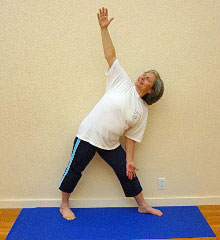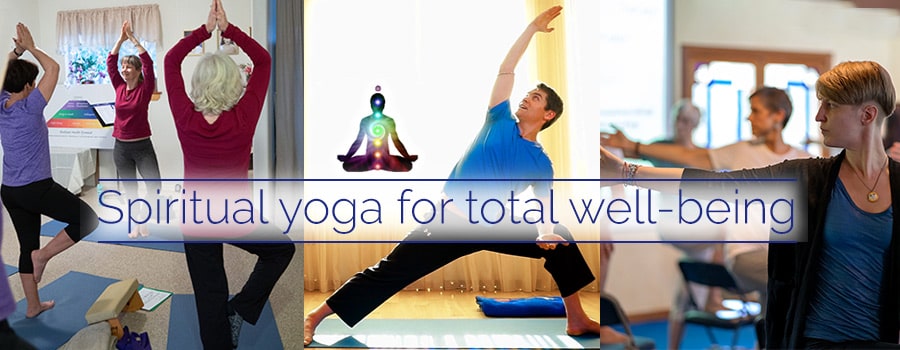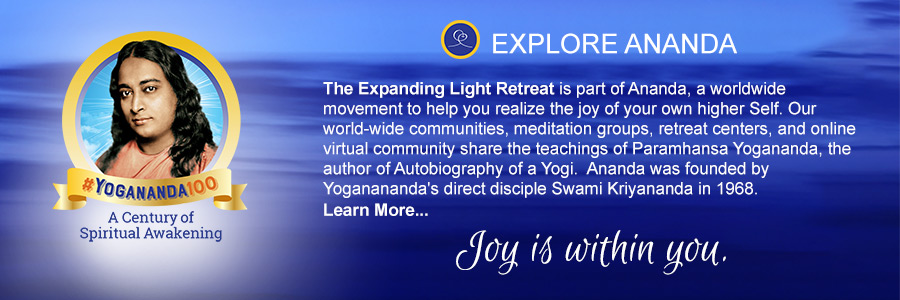Helping Students Master the Asanas
Part One: Understanding Mastery
May 11, 2010
|
This article was written for the Ananda Yoga® Teacher Association newsletter. Learn more, or find a certified Ananda Yoga® teacher near you. |
Download pdf (1.3MB)
“Will I ever be able to do ____?” [Fill in the blank with a popular yoga asana.] This is a question that I often receive from my students. They have seen the pictures in the books and watched some of their classmates glide—seemingly effortlessly—into a pose that is challenging to the watchers.
I never answer with a simple yes or no. Instead I usually say, “I can help you work toward mastering the pose safely, perhaps first with building-block asanas.” Sometimes I say, “I don’t know if you will be able to do the full classical position or not, but you can still reap many, if not all, of its benefits without ‘looking like the picture in the book.”
Students come to us in many different shapes and sizes, with different physical, mental and spiritual talents and limitations. Our job is to help all of them work toward achieving mastery in their asana practice. So let’s first get a sense of what “mastery” means.
The many guises of mastery
In order to know how best to go about mastering a pose, it will help if we first explore what it means to master a pose. If a student is reaping all of the benefits—physical, psychological, spiritual—from an asana, has she mastered the pose, even if her body is not classically positioned? If a student’s body is classically positioned, but he is not experiencing any of the benefits of the asana, has he mastered the pose?
To begin to answer these questions, let’s consider the following statements about Trikonasana (Triangle Pose) from three imaginary students.
- “I can touch my fingers to the floor now!”
- “When I’m in the pose, I don’t feel any stretch or have any difficulty holding the pose.”
- “What joy! What energy I feel!”
Which statement do you think best illustrates mastery of Trikonasana?
If your view of mastery of an asana is circumscribed by the physical ability to, in essence, “look like the picture in the book”—in this case, to have your feet pointing in the right directions, arms properly placed with the lower hand or finger tips touching the floor etc.,—then you might have chosen the answer A.
If your view of mastery of an asana includes the above, but also incorporates a feeling of ease and effortlessness, then I suspect that you would have chosen the answer B.
However, if you view mastery of an asana more in terms of prana yama (not to be confused with breathing techniques called pranayama)—i.e., one’s ability to direct physical effort and subtle energy while in the asana—then, like me, you probably chose answer C. Even if the student’s goal was purely physical (say, to eliminate back pain), then the goal has still been achieved if the student is eliminating and/or transcending the pain.
Then too, some of you may have answered “all of the above.” We will discuss that answer later in the article.
Three angles on Trikonasana
Ultimately yoga is about one’s inner experience. While many people are familiar with the physical benefits of Trikonasana, not all are aware of the psychological and spiritual benefits. For example, properly practiced, Trikonasana can produce an inner experience of energy and joy surging through one’s body and mind. To me, mastering the pose means achieving this state, along with its attendant physical benefits.
Of course, different asanas will lead to different experiences, such as those of deep calmness, strength, and courage, or a feeling of being flooded with peace. Nayaswami Kriyananda’s asana affirmations (see note at end of article) are a guide to what state of mind asanas can help students to experience, as well as tools to help them have those experiences. Inherent in being able to access these states through the yoga asanas, is a practice that is safe for one’s physical body. Such mastery brings about benefits on all levels—physical, mental, and spiritual.
 |
 |
 |
Continuing with the example of Triangle Pose, let’s pretend that in my yoga class are three students: Victoria, Mark, and Edith. Let’s see what we can learn about mastery from they way they do Trikonasana.
We’ll begin with Victoria (top photo at right). As you can see, Victoria is quite flexible: She’s fully in the pose, with her hand flat on the floor. You might even be able to see a bored and distracted look on her face. This is just too easy, right?
Now let’s move to Mark (middle photo at right), a young athletic type—a real gogetter who is absolutely determined to master the poses. Perhaps you can see him hunching his shoulders and back, hyperextending his neck and his knees, forehead furrowed, and fingertips reaching desperately—and barely!—to the floor. Can’t you almost hear him breathing heavily and unevenly?
Now let’s turn to Edith (bottom photo at right), who’s a bit older—and a lot less flexible—than Victoria, or even Mark. Notice that her legs are well positioned (though her front knee is slightly bent), her spine (although straight) is lengthened only a little ways to the side, and her fingertips barely reach to her knee. Her short, tight neck allows her to gaze only slightly upward. Not so great, right? But wait a minute: Check out the blissful, joyful expression on her face. Maybe something else is going on here …
First aid for mastery
Okay, so which student(s) need my assistance?
I would first assist Mark—and quickly at that! Not only are his hyper-extended knees in trouble, but he is also stressing his neck. I prefer to prevent injuries rather than share a student’s enthusiasm for unsafely contorting the body to “look like the picture in the book.” By the way, Mark is probably the student who feels he mastered the pose by getting his fingers to the floor: He triumphantly made Statement A above “I can touch my fingers to the floor now!”
Next I would help Victoria. Since she is not in a position that was unsafe for her body, I would probably wait to make corrections for her as I lead the class into the pose on the second side. (Mark needed so many corrections, simply in order to be safe, that there probably wouldn’t have been time to work with others individually on the first side.) I would talk the class through the spinal alignment and core engagement aspects of the pose, being sure to make a lot of eye contact with Victoria. You see, she has long arms and is very flexible, so it was easy for her to lean over in the pose and place her hand on the floor supporting herself with her arm, without engaging any trunk muscles. After all, it’s not that the trunk muscles need to be engaged in order to hold what appears to be the “right” position—Victoria is proving that. Rather, it’s that, if she leaves her body in a position where the trunk needs to be engaged in order to keep the spine straight, then she’ll get much more out of the pose.
You can see why she might feel bored in the pose the way she was doing it, and was the one to say “When I’m in the pose, I don’t feel any stretch or have any difficulty holding the pose.” (Statement B)
For Victoria to experience the benefits of Trikonasana, she needs to move just from her hips rather than from her waist and hips, so that her entire spine remains straight (i.e., in its natural curves) all the way to the tailbone. Because she is so flexible, her spine will be parallel to the floor while in the pose. She also needs to engage her core muscles to keep her spine straight as she places only her fingertips lightly onto the floor (which might mean that her wrist or elbow may be slightly bent because of her long arms). Victoria is going to be surprised at how challenging the asana becomes when she must use her strength and energy to maintain the pose.
As for Edith, what can I say? “Beautiful!” I tell her with a joy-filled, knowing smile.
Enter the affirmation
Energy and joy
flood my body cells!
Joy descends to me!
Now when I had this class first go into Trikonasana, with energy and joy in my voice, I invited them to repeat the affirmation silently: “Energy and joy flood my body cells! Joy descends to me!” Mark thought I said the wrong affirmation for the pose, as he muscled his way into it. Victoria just thought I was being overly enthusiastic. For Edith, the affirmation took her into another dimension of the pose as she began to experience the statement as a reality, and not as a mere affirmation. She was saying internally: “What joy! What energy I feel!” (Statement C)
As I led the class into the second side of Trikonasana, I mentioned that, if the affirmation is not making sense, then they need to make corrections to their pose. Not only was Mark practicing more safely on the second side, but being the type A personality that he is, he was determined to figure out how to feel some joy in his practice of Trikonasana—he wanted to be doing everything “right” as well as get his money’s worth. Victoria was energized, and felt not only energy where none had been present before, but also a subtle positive attitude change that made her smile inside. And Edith— with her not-so-flexible body and very short arms and torso—was amazed that when she focused more deeply on experiencing the affirmation, she felt a release in her hips, and a joyful surge of energy flowed up her spine to her spiritual eye as she went farther than she ever has before into the asana.
Was I just humoring Edith when I said “Beautiful!” since she was practicing safely at least? Not at all. Edith was the only one of the three coming close to mastering the asana on a deeper level.
Could all three statements be correct?
Consider that, if mastery of Trikonasana required the attainment of all three states from the statements above, Edith would never be able to master Trikonasana because of her body proportions. Her relatively short arms would never allow her fingertips to touch the floor, no matter how flexible she becomes, without contorting her body in a way that might stress her spine. The stress and strain would not only be unsafe practice, but it would further prevent an upward flow of joyful energy to her brain.
People who pose for yoga postures in books and magazines tend to be people with body proportions that are relatively even. They are not the folks with extra-short or extra-long legs, arms, torsos etc. Even the shape of our feet can make a particular pose easier or more difficult to assume.
Furthermore, how our bodies are put together anatomically inside affects our ability to assume certain positions or not. For example, the exact shape of our femur (thigh bone) and the shape of our acetabulum (hip socket) and how they fit together determines one’s maximum ability for inward and outward rotation at the hip joint. If mastery of a pose means getting the physical, psychological, and spiritual dimensions of your being all moving in the right direction in a given pose—rather than trying to look like the picture in the book—then we see that we all have the potential for mastery. Otherwise we might as well say when encouraging new yoga students to attend our classes, “Those without perfect body proportions need not apply!”
Master, don’t mimic, the asanas
If we simply try to have our students always look like the picture in the book, then we will be practicing mimicry, not attempting mastery. After all, a mockingbird may be able to whistle or even say a word, but it does not understand the meaning behind the mimicry. It is experience, meaning, and positive results—found safely—that we should wish for our students and for ourselves.
In the next parts of this article, we will explore proportion, range of motion and other factors that need to be considered in order to help students achieve mastery in their asana practice. As teachers we will learn how to help, not only the Victoria’s, Mark’s, and Edith’s who show up to our classes, but also the Henry’s, Lori’s, David’s, Beth’s, and all of the rest!
* Many of the asana affirmations can be found in Kriyananda’s book, The Art and Science of Raja Yoga. All of them appear in a deck of Ananda Yoga flash cards.
Related
- Helping Students Master the Asanas, Part Two: Proportion
- Power Yoga — Ananda-Style!
- Engage Your Core?
- Tadasana, the Standing Mountain Pose
- Forward and Backward Bends
All authors are graduates of Ananda Yoga Teacher Training.





















